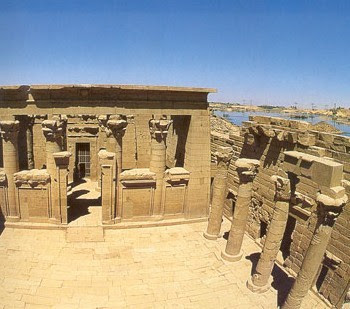
There is increasing evidence that the Beja may provide a key to fully understanding the Meroitic language.
Some years ago I deciphered the Kharamadoye inscription. Today Beja repeat this message from their ancestors with pride as an indication to the long history of the Beja people. At Buzzle.com
http://www.buzzle.com/articles/freedom-for-dirar-ahmed-dirar-independence-for-sudans-beja-blemmyes.html
They note:
…… Hrmdoye ne qor ene ariteñ lne mdes ne mni-t kene
mk lebne ye re qe-ne q yi-t hl-ne y es bo he-ne q r lebne tro.
S-ne ariteñ net er ek li s-ne d-b li lh ne q r kene qor ene mnpte.
This was heard already before 1670 years at a moment the Blemmyan King Kharamadoye drove his compatriots to a point of national statehood at the northern area of the then ailing Meroitic kingdom in what is today's Sudanese North and Egyptian South. Using Meroitic scripture, the scribes of Kharamadoye immortalized down to our times an inscription on walls of the Mandulis temple at Talmis (modern Kalabsha). The beginning of the inscription reads in a plausible English translation as follows:
Kharamadoye the monarch and chief of the living Ariteñ, the great son and patron of Amani, you (who) revitalizes (man). The lord's voyage of discovery indeed gives the creation of Good. Act (now Amani) he travels to support good. Make a good welfare swell (for) the offering of the Chief, (he) desires indeed the restoration of eminence. The patron of good Ariteñ bows in reverence (before Amani) to evoke exalted nourishment (for) the patrons to leave a grand and exalted legacy to behold good. Oh Amani make indeed (a) revitalization (of) the monarch (and) commander of Great Napata…..”
When I first saw this claim that the Beja, represented the Blemmyan people of the Meroitic and Egyptian inscriptions I thought it might be hollow indeed. But after comparing Meroitic to Beja, the claim has considerable merit.
To test the hypothesis that the Beja language was related to meroitic, I compared Meroitic and Beja. The Beja material comes from Klaus and Charlotte Wedekind and Abuzeinab Musa, Beja Pedagogical Grammar (http://www.afrikanistik-online.de/archiv/2008/1283/beja_pedagogical_grammar_final_links_numbered.pdf ) ,
What I found from this cursory examination was most interesting. I will need to gather more vocabulary items from Beja, but I did find a number of matches:
Meroitic ……English……….. Beja
i ‘arrive at this point’ ………… bi ‘went’
t ‘he, she’ ……………………..ta ‘she’
ya ‘go’………………………….yak ‘start’
rit ‘look’……………………….rhitaa ‘you saw’
an(a) plural suffix……………..aan ‘these’
d(d) ‘say’………………………di(y) ‘say’
lb ‘energy, dynamic…………liwa ‘burn’
ken ‘to realize’……………….kana ‘to know’
bk ‘ripen’……………………..bishakwa ‘to be ripe’
The vocabulary items are interesting, but since they come from a grammar book there was not enough to provide an extensive comparison.
Meroitic and Beja share many grammatical features. For example, the pronouns are usually suffixed to verbs e.g., Beja ti bi ‘she went’, Meroitic t-i ‘he goes’. In Beja, adi is used to indicate complete action Taman adi ‘I ate it completely’, Meroitic –a, serves the same purpose akin ne a ‘he has become completely learned’. In both languages the adverb is placed behind the noun Beja takii-da ‘small man’, Meroitic pt ‘praise’: pt es ‘manifest praise’. In Beja the future tense is form by ndi, Tami a ndi “I will eat’, Meroitic –n, s-ne yo-n Aman ‘The patron will bow in reverence to Aman’.
Kalabsha Temple

This makes it clear to me that Beja may be related to Meroitic and that the Beja represent the Blemmy nation of Old.

No comments:
Post a Comment